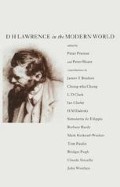Abstract
Surveying the contemporary scene in the world of British fiction in 1914, Henry James praised H. G. Wells and Arnold Bennett for having ‘launched the boat’ in which the most promising younger novelists were then setting out with a ‘fresh play of oar’, and he named these as Hugh Walpole, Gilbert Cannan, Compton Mackenzie and D. H. Lawrence, though he added that he found Lawrence hanging very much ‘in the dusty rear’.1 James Joyce was not even aboard that particular craft of fiction, but then Dubliners was first published only some months after James’s essay was writtep. When we look back on the intervening years from the vantage point of 1985, however, I think it would be generally agreed that it is Lawrence and Joyce who are the major British novelists of the century. In Lawrence’s centenary year, therefore, it seems fitting to couple him with Joyce, whose own centenary was marked a few years ago. In the popular imagination, of course, they have long been linked in very different terms - as the notorious authors of banned books, the purveyors of unmentionable fourletter words. Though tarred with the same brush, they did not regard themselves as pursuing similar aims in their treatment of sexual matters or in their use of such words, and they did not even agree as to what constituted pornography. ‘Pornography,’ said Lawrence, ‘is the attempt to insult sex, to do dirt on it.’2 ‘Desire,’ wrote Joyce in the Paris Notebook, ‘is the feeling which urges us to go to something and loathing is the feeling which urges us to go from something: and that art is improper which aims at exciting these feelings in us ...’,3 Stephen Dedalus, following this line of thought in A Portrait of the Artist, puts a name to such improper arts and calls them ‘pornographical or didactic’.4
Access this chapter
Tax calculation will be finalised at checkout
Purchases are for personal use only
Preview
Unable to display preview. Download preview PDF.
Notes
Henry James, ‘The New Novel’, The Future of the Novel: Essays on the Art of Fiction, ed. Leon Edel (New York: Vintage Books, 1956; first published 1914) pp. 260–1.
‘Pornography and Obscenity’, Phoenix, p. 175.
The Critical Writings of James Joyce, ed. Ellsworth Mason and Richard Ellmann (New York• Viking Press 19731 n 143
James Joyce, A Portrait of the Artist as a Young Man, text as edited by Chester G. Anderson and Richard Ellmann, in The Portable James Joyce, ed. Harrv Levin tHarmondsworth. Middx: PenQUip. 19771 n 471
D. H. Lawrence, Lady Chatterley’s Lover (Harmondsworth, Middx: Penguin, 1961) p. 104.
James Joyce, ‘Paris Notebook’, The Critical Writings, p. 144.
Joyce, A Portrait of the Artist, p. 483.
Letter to Carlo Linati, 22 January 1925, Moore, II, p. 827.
‘Why the Novel Matters’, Phoenix, p. 535.
See Jacques Derrida, ‘Two Words for Joyce’, Post-structuralist Joyce: Essays from the French, ed. Derek Attridge and Daniel Ferrer (Cam-bridge: Cambridge University Press, 1984) pp. 145–59.
D. H. Lawrence, Women in Love, ed. Charles L. Ross (Harmondsworth, Middx: Penguin, 1982) pp. 395–7.
Ibid., p. 391.
Ibid., p. 402.
Ibid.
Ibid., p. 387.
Jovice, A Portrait of the Artist, pp. 432–4.
Ibid., pp. 430–1.
D. H. Lawrence, The Rainbow, ed. John Worthen (Harmondsworth, Middx: Penguin, 1981) pp. 111–12.
Ibid., p. 116.
James Joyce, Ulysses (Harmondsworth, Middx: Penguin, 1983) p. 384.
Ibid., p. 390.
Ibid., p. 294.
Ibid., P. 295.
‘Surgery for the Novel - Or a Bomb’, Phoenix, p. 518.
D. H. Lawrence, ‘The Horse Dealer’s Daughter’, The Complete Short Stories vol. ii (London: Heinemanp. 19581 p. 442.
Ibid., pp. 452–3.
Ibid., p. 453.
Ibid., p. 448.
Lawrence, Lady Chatterley’s Lover, p. 117.
Ibid., p. 7.
Ibid., p. 8.
Ibid., p. 96.
Ibid., p. 117.
Ibid., p. 118.
Ibid., p. 119.
Editor information
Editors and Affiliations
Copyright information
© 1989 H. M. Daleski
About this chapter
Cite this chapter
Daleski, H.M. (1989). Life as a Four-Letter Word: a Contemporary View of Lawrence and Joyce. In: Preston, P., Hoare, P. (eds) D.H. Lawrence in the Modern World. Palgrave Macmillan, London. https://doi.org/10.1007/978-1-349-09848-4_6
Download citation
DOI: https://doi.org/10.1007/978-1-349-09848-4_6
Publisher Name: Palgrave Macmillan, London
Print ISBN: 978-1-349-09850-7
Online ISBN: 978-1-349-09848-4
eBook Packages: Palgrave Literature & Performing Arts CollectionLiterature, Cultural and Media Studies (R0)

